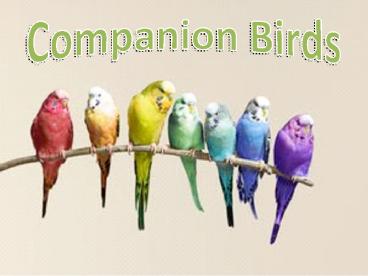Companion Birds - PowerPoint PPT Presentation
1 / 22
Title:
Companion Birds
Description:
Companion Birds Increasingly popular 16 million pet birds Great responsibility Specific nutritional and housing requirements Lifetime commitment Many species live 50 ... – PowerPoint PPT presentation
Number of Views:601
Avg rating:3.0/5.0
Title: Companion Birds
1
Companion Birds
2
Companion Birds
- Increasingly popular
- 16 million pet birds
- Great responsibility
- Specific nutritional and housing requirements
- Lifetime commitment
- Many species live 50 to 100 years
3
Companion Birds
- Many reasons why birds are ideal pets
- Highly intelligent
- Easy to train inquisitive and smart
- Require minimal grooming
- Highly social
- Fairly inexpensive to feed
- Can be kept in small spaces
- Beautiful animals
- Long-lived companions
https//www.youtube.com/watch?vdKvVaRlz0Y4 Alex
the African grey
4
Companion Birds
- Psitticiformes
- Most common companion bird
- Over 300 species
- Parrots
- Macaws
- Cockatoos
- Passerines
- Mostly songbirds
- About 5,400 species
- Finches
- Canaries
5
Common Companion Birds
- Amazon Parrot
- Budgies
- Canaries
- Cockatiels
- Cockatoos
- Conures
- Electus Parrots
- Love Birds
- Macaws
- Quaker (Monk Parakeets)
- Parrotlettes (Dwarf Parrots)
6
Feathers
- Made of keratin
- Provide waterproof covering
- Facilitate flight
- Arranged in tracts or pterylae
- Unfeathered areas are apteria
7
Feathers
- Calamus (quill)
- Below skin level
- Hollow central stalk
- Rachis
- Above skin level
- Barbs and barbules interlock
- Blood feathers
- contain artery
- Molt regularly
8
Feathers
- Contour feathers
- Give bird shape and color
- Include flight feathers (remiges), tail feathers
(retrices) - Down feathers
- Smaller
- Lack barbules
- Provide insulation
- Powder feathers
- Barbs break down into powder
- Believed to keep plumage clean
9
Feathers
- Molting
- Old feathers replaced with new ones
- Most species molt 2 to 3 weeks a year
- Amazon parrot molts year round
- Metabolic rate increases about thirtyfold
10
Beaks
- Consist of bones and keratinized covering
- Grows throughout life of bird
- Replaces wearing at tips
- Upper jaw (rhinotheca)
- Lower jaw (gnathotheca)
11
Skeletal System
- Light weight
- Maintain strength
- Most are pneumatic
- Hollow and filled with air spaces connected to
the respiratory system
12
Digestive System
- Two-part stomach
- Proventriculus (glandular stomach)
- Gizzard (muscular stomach)
- Terminal end of digestive, reproductive, and
urinary tracts is the cloaca
13
Digestive System
- Esophagus expanded into the crop which stores
and softens food and regulates its flow through
the digestive tract - Stomach
- proventriculus has digestive enzymes
- gizzard functions as teeth
14
Circulatory System
- Warm-blooded animals
- Normal body temperature of 106ºF (41ºC)
- Four-chambered heart
- Beats much faster than human heart
15
Aviaries
- Provide space for birds to fly freely
- If temperatures drop below freezing, birds must
be moved indoors - Requires indoor cages to accommodate ALL birds in
aviary
16
Aviaries
17
Common Toxicological Hazards
- Zinc
- Sources include wire, screws, nuts, bolts,
pennies - Galvanized cages and dishes present risk
- Can affect kidneys, liver, and red blood cells
- Symptoms include
- Increased thirst
- Diarrhea
- Seizures and death
18
Common Toxicological Hazards
- Lead
- Sources include many household items and fixtures
- Paint
- Toys
- Galvanized wire
- Improperly glazed bowls
- Most commonly reported avian toxicosis
- Affects multiple tissues
- Symptoms include
- Lethargy and weakness
- Ataxia
- Circling and convulsions
This radiograph shows normal grit in the gizzard,
but some of the grit looks brighter than normal.
The brighter objects are lead particles, not grit.
19
Common Toxicological Hazards
- Nicotine
- Found in cigarettes, cigars, and cigarette butts
- Natural form of insecticide
- Rapid onset of symptoms
- Excitation
- Panting and salivation
- Vomiting
- May be followed by breathing difficulty and
collapse - Death is secondary to respiratory paralysis
- Common response to smoke deposition on feathers
is destructive behavior
20
Common Toxicological Hazards
- Inhalants
- Strong odors or smoke are potentially toxic
- Cookware and utensils coated with
polytetrafluoroethylene when overheated - Symptoms include
- Acute death
- Breathing difficulty
- Depression
- Restless behavior
21
Common Toxicological Hazards
- Avocado (Persea americana)
- Principle toxin is persin
- Symptoms include
- Respiratory distress
- Congestion
- Death
- Onset of symptoms within 12 hours, death within 1
to 2 days - Canaries and budgies more susceptible
22
Common Toxicological Hazards
- Plants
- Certain plants cause toxicity
- Calcium oxalate crystals
- Cause irritation of oral cavity and tongue
- Symptoms include regurgitation, pain, and
anorexia - Signs rarely severe, usually respond to care































